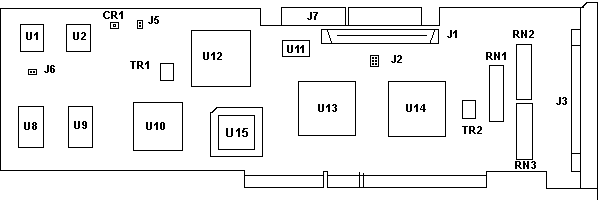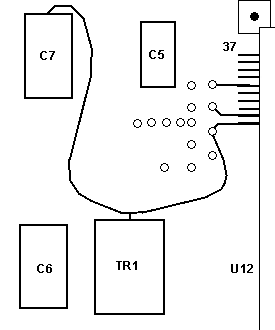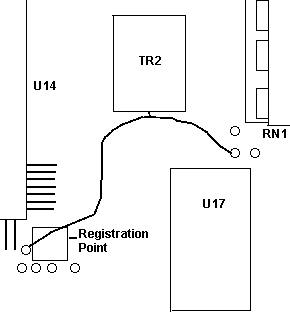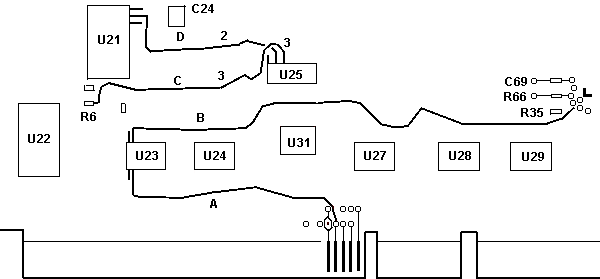|
SCSI-2 DF/W
ADF @8efc.adf
Init File c8efc.adf
rev71upd.exe
SCSI-2 Fast/Wide Adapter Firmware Upgrade 7.1
ibm2.exe
F/W and OS/2 2.1 Fix '94 (ibm2scsi.add and ibm2m57.add)
scsi2fw.exe
SCSI-2 F/W Support Diskette v2.0
scsi2fw.txt
Readme for scsi2fw.exe
Oct. 1994
... IBM TECHNICAL DISCLOSURE BULLETIN ...
Adapter Microcode Protection during Download
193-294
SCSI-2 F/W Adapter/A
194-145
SCSI-2 F/W Adapter/A, SCSI-2 Differential F/W Adapter/A
How Many IBM SCSI Adapters Can I put in My System?
SCSI-2 Fast/Wide Adapter/A
Specs
Differential SCSI-2 Fast/Wide
Adapter FRU 11H3599 / 11H7660
Rework on 11H7660 Front
Rework on 11H7660 Back
Enhanced Differential
SCSI Fast/Wide Adapter FRU 52G3380
Fast/Wide in 8590/8585
80C188 vs. 80C186
Three Port Operation
PTC Function
PLCC Socket on Fast/Wide
Jumpers on the Fast/Wide
68 pin Internal
Connector
Drive connector
SCSI
device and adapter configuration flexibility
SCSI Device Order
Maximum SCSI Devices
Supported
Fast POST Consequences
Configuration
Options @8EFC.adf 4/10/95
I/O Address
DMA
Arbitration Level
SCSI
Adapter Address (ID)
Move Mode Support
Wait State
Support
Data
Parity Exception Handling
Selected
Feedback Return Exception
100ns
Streaming Data Transfer Support
Target Mode
SCSI
Disconnect
Fast
SCSI - External
Wide
SCSI messages - External
Wide
SCSI messages - Internal
Internal/External
Bus Mode
System Determined
ROM Address
Range
ESDI Requirements
Trivia
° IBM SCSI-2 Fast/Wide Adapter/A
The IBM SCSI-2 Fast/Wide Adapter/A
is a SCSI-2 adapter that IBM has announced as an option for it's range
of PS/2s. Fast refers to a data transfer method. With fast, data
is moved to fixed disks at 10MBps--twice the speed of SCSI 1. Wide
refers to the bus width which is increased from 8 to 16 bits, enabling
transfers of up to 20MBps.
The IBM SCSI-2 Fast/Wide Streaming
Adapter/A is a high performance SCSI-2, 32-bit Micro Channel 40MBps Data
Streaming bus master adapter. It has dual SCSI-2 16-bit, fast and wide
channels (one 20MBps internal, one 20MBps external). The dual
bus of the adapter prevents access to internal DASD from the external port
and also allows the maximum cable length to be calculated individually
for each bus. This allows for additional capability externally.
This adapter has a dedicated 80C186
local processor on-board. It supports SCSI Tagged Command Queuing
(TCQ) which increases performance in DASD-intensive server environments.
With SCSI-1 systems, only two commands could be sent to a fixed disk -
the disk would store one while operating on the other. With TCQ it is possible
to send multiple commands to the fixed disk, and the disk will store the
commands and execute each command in the sequence which will give optimal
performance.
The supporting cables and terminators
allow attachment of SCSI devices internally or externally for PS/2 Models
8590/95 and 9585/90/95. Up to seven SCSI physical devices may be
attached. The IBM SCSI-2 Fast/Wide Adapter/A also supports standard 8-bit
SCSI devices using either asynchronous, synchronous, or fast synchronous
(10MBps) SCSI data transfer rates per ANSI Small Computer System Interface
2 (X3T9.2/375R REV10K) for SCSI-2 features.
How Many is Enough?
Tim Clarke uttered this after
a pint of warm beer:
All **IBM** SCSI CBIOS-flavour (i.e. *not* FD MCS700 OEM)
will share IRQ14 and you only need one BIOS ROM enabled to drive multiple
adapters. So, for example you *should* be able install (in the same slot-type,
please) IBM F+W SCSI-2 "Corvette", IBM SCSI w/cache ("Spock") and IBM SCSI
w/o cache ("Tribble") in the same PS/2. No naughties like AHA1640, Storage
Dimensions unless you disable their BIOS ROMs and assign a different IRQ.
OS Limits
Not all Micro$haft products support multiple IBM SCSI adapters
gracefully. W9x cannot handle shared IRQs and will drop into MS-Doze (In)compatibility
mode. Win NT handles the shared Interrupts.
For some odd reason, OS/2 can handle shared interrupts.
I wonder why? IBM wrote it to run on the PS/2, among other systems...
Linux supports shared Interrupts.
J7 Pinout
25 May 00 - I was surfin through
IBM's patent info/Tech Discovery Bulletins, and I found a TDB that identified
the Burn/Alive/TXD/RXD as being used to flash certain components. Of course
I didn't bookmark it... Basically, factory use only.
Contact tab 20 preferably has ten contact pads 21,
with five such pads on each side of card 10. Three of these pads 21 are
connected to the ground plane of card 10, and two of these pads are connected
to the plus five-volt plane. The remaining five pads 21 are connected to
transmit signals, with an RXD (receive data) input signal line being paired
with a TXD (transmit data) output signal line to form a serial data link
to the card, having a protocol similar to that of the RS-232 interface.
A typical application of this kind of data link includes connection to
an ASYNCH port on the local processor of card 10. Alternately, a two-bit
I/O port controlled by software timing loops may be connected. Two
other input lines supply the CHRESET (channel reset) signal, which is the
general reset signal of the system bus, and the BURNIN signal, which is
an active low signal to the adapter, establishing a special burn-in mode.
For example, the adapter may use this signal to branch to a special set
of diagnostic microcode. A pull-up resistor on the feature card renders
this signal inactive during normal operation and offers protection against
electrostatic discharge. Finally, an output line transmits the ITSALIVE
signal, an active high signal indicating the status of card 10.
The status report of the ITSALIVE signal can be
as simple as driving the associated line to a high level for 1/2 second
after the completion of each diagnostic loop. This information can be used
within the test fixture to drive an LED in various flashing patterns,
indicating the condition of the card under test.
80C188 vs.
80C186
Older adapters (SCSI, SCSI w/cache) use an 80C188-16 microcontroller
as busmaster-CPU, the Fast/Wide uses an 80C186-20 busmaster CPU.
Both CPUs however are integrated CPUs with 2 8-bit parallel-ports,
the -188 has 8-bit external data-path, the -186 has 16-bit external data-path
and slightly different (enhanced) command set.
Three Port Operation
You should not run both internal ports and the external
port all at once. I have done just that for over six months with no significant
problem, but it makes the SCSI drive circuitry work harder than it should.
Fast/Wide in 8590/8585
If you don't have a Type 4 complex on a 95A (dual serial/dual
parallel), you may not be able to use some features of the Fast/Wide, most
notably Internal/External Bus Mode. You need to run
SCSI2FW.EXE
to update the system partition.
Differential SCSI Fast/Wide
Adapter FRU 11H3599 / 11H7660

CR1 LED
J1 50 pin
SE SCSI connector
J2 Factory use
J3 C-68 DFW SCSI connector
J5 Leave open. Not used.
J6 Boot Enable
J7 FW SE SCSI connector
RN1,2,3 Used for RS6K stuff
TR1 PTC resistor for internal bus
TR2 PTC resistor for external bus |
U1 61G3929, SCSI BIOS, Odd
U2 61G3930, SCSI BIOS, Even
U8,9 Sony CXK581000AM-70LL
U10 AMD N80C186-20
U11 40.0000 MHz osc
U12 82G2645 Int SE SCSI ctrlr
U13 61G2323 MCA Bus interface
U14 52G9707 Ext Diff SCSI ctrlr
U15 empty (unused even in RS6K)
1 |
RN1,2,3 Removed on RS/6000 systems
when a high-reliability configuration is used (one of them there "Y" arrangements
illegal to normal SCSI users).
The SCSI-2 Differential Fast/Wide Adapter/A supports an internal
single-ended and an external differential SCSI bus.
FRU 11H3599
To date, all attempts to get this RS/6000 adapter to work in a PS/2
have failed. Although the chipset is the same as on the Fast/Wide, the
rev .71 flash update does not recognize a F/W chipset.
FRU 11H7660
Much to my suprise, the 11H7660 configures fine, flashes
to .71, and works like a normal F/W.
Front 11H7660
DFW Rework
 
Rear 11H7660
DFW Rework

Rework A comes off the fourth MCA contact.
Rework B comes off the solder pad marked with a V.
Rework C comes off the third pin on the upper left of U23.
Rework D comes off the second pin of U23.
Jim Shorney rains on our parade- he warns that foil cuts may have been
made in addition to the rework wires.
Enhanced Differential
SCSI Fast/Wide Adapter FRU 52G3380

CR1 LED
J1 FW
SE SCSI connector
J2 50 pin
SE SCSI connector
J3 C-68 DFW SCSI connector
J5 Leave open. Not used.
J6 Boot Enable
J7 Factory use
RN1,2,3 Used for RS6K stuff
TR1 PTC resistor for internal bus
TR2 PTC resistor for external bus |
U1 88G1094, SCSI BIOS, Odd
U2 88G1095, SCSI BIOS, Even
U4 82G2645 Int SE SCSI ctrlr
U9,10 Sony CXK581000AM-70LL
U11 AMD AM186 EM-40VC
U12 88G1092
U13 88G1093
U16 61G2323 MCA Bus interface
U17 52G9707 Ext Diff SCSI ctrlr
Y1 40.0000 MHz osc |
PTC Function
There is one PTC for the internal SCSI bus and another
for the external bus. The PTC protects the SCSI bus from high currents
due to shorts on the cable, terminator, or device. It is highly unlikely
that the PTC resistor can be tripped by a defective adapter.
A fault (short circuit) causes an increase in PTC resistance
and temperature. The increase in resistance causes the PTC resistor to
halt current flow. The PTC resistor returns to a low resistive and low
temperature state when the fault is removed from the SCSI bus or when the
system is powered off. Wait 5 minutes for the PTC resistor to fully cool,
then reset.
MF-SM Series MF-SM150
PLCC Socket on Fast/Wide
The PLCC Socket U7 was possibly to provide a RS6000 Bios, and
the jumper J5 might have been to enable it. Documentation for the RS6000
says that PLCC socket is unused.
Jumpers on Fast/Wide
The results of shorting the jumpers ranged from no difference,
slight performance hit (%10 overhead increase) or a system-halting error.
Leave them off. RS6000 documentation says the jumpers are to be left open.
Jumper J5 has a lead going to U6, chip 82G2645. Purpose
unknown.
Jumper J8 has a lead going to U5, chip 61G2323. Purpose
unknown.
Jumper J4 has a lead going to U3, chip 82G2645. Purpose
unknown.
68
pin Internal Connector on F/W SCSI Adapter
This is a "mini-Centronics" or a Vesa Media Channel plug.
The ANSI moniker for it is a "P" plug. Also seems to be used for SCA drives...
Hmm...
AMP (and Tyco) # 1-557089-2
Looks like THIS
or if you want the page go HERE
Newark Electronics 97F8813
CHAMP. 0.050 I Series Interface Connectors For VMC Applications: 68-Position
$6.78 each
The AMP part is designed for use with 30 AWG solid conductors on .064mm
(.025") centers. For details, look HERE
Molex 71660i Molex part 15-92-3068
1.27mm (.050") Pitch
EBBI™ 50D - Receptacle, Vertical, IDT 71660i Looks like THIS
Terminates to 30 AWG solid or stranded.025" ribbon cable
or laminated discrete wire cable
Drive connector
The 68 pin crimp-on device connector. Dalco 59611
$4.25

SCSI
device and adapter configuration flexibility
Systems with the enhanced SCSI device and adapter support
allow up to 8 IBM PS/2 SCSI adapters of any type to be installed in a single
system. The maximum number of SCSI devices which many be configured in
these newer systems has also been increased from 60 to 120. However,
other factors, for example, the type of devices (optical, etc.), cooling
requirements, or power consumption of the devices may limit the number
for a particular system.
SCSI Device
Order
SCSI device logical ordering and hard drive letter assignment
(e.g. C:, D:) sequence is determined by the SCSI adapter slot numbers,
internal or external SCSI bus connection, and SCSI ID of the connected
devices.
Adapters are scanned for SCSI devices beginning with the
SCSI adapter in the lowest numbered slot. Devices connected to the
same adapter are logically ordered according to device SCSI IDs in order
from 7 to 0 and then from 15 to 8 according to the priority scheme defined
by the SCSI standard. Devices connected to a SCSI-2 Fast/Wide adapter's
internal bus connector are ordered logically before devices connected to
the external bus of the same adapter.
Maximum SCSI
Devices Supported
Wide SCSI devices support 16 possible SCSI ID values.
The adapter uses one these values; therefore, the SCSI-2 Fast/Wide adapter
can connect up to 15 fast and wide devices internally or externally in
any combination using the remaining ID values. Narrow SCSI devices
support 8 possible SCSI ID values; therefore, up to 7 narrow SCSI devices
can be connected to the internal or external SCSI busses in any combination
using the remaining ID values. Wide and narrow devices may be mixed
on the same internal/external bus by using the proper combinations of SCSI
bus cables, terminators, and/or SCSI connector convertor adapters.
NOTE: Use of a 8 bit
(Narrow) cable forces the controller to default to only 7 devices supported
on that port, even if all devices on that cable are Wide.
Fast POST Consequences
Some newer systems also provide a FAST POST option which
may be selected from the system configuration menu or from the IBM logo
screen. When this option is selected, the system will not check for
the presence of newly added SCSI devices unless F1 is also pressed while
the IBM logo is displayed. Newly added SCSI devices will not be configured
nor will an error occur if the fast post option is chosen as the default.
To access the system configuration program, press F1 while the IBM logo
screen is displayed to configure the new SCSI device(s) initially.
Configuration
Options @8EFC.adf 4/10/95
I/O Address
This allows you to choose the I/O address for the adapter.
Each adapter must have a unique address range. Normally this address range
does not need to be changed.
I/O Addresses available are: <3540-3547>,
3548-354F, 3550-3557, 3558-355F, 3560-3567, 3568-356F, 3570-3577, 3578-357F,
3578-357F
DMA Arbitration
Level
Choose the Arbitration level used by the adapter to transfer
data.
Arbitration Levels available are: <C>,
D, E, 8, 9, A, B, 1, 3, 5, 6, 7
SCSI Adapter
Address (ID)
This allows you to change the SCSI ID of the adapter.
Adapter IDs available are: <7>,
6, 5, 4, 3, 2, 1, 0
Move Mode Support
Allows you to Enable or Disable Micro Channel Subsystem
Control Block Move Mode This is the second mode of SCBA (first is locate
mode) which permits the system processor to move the subsystem control
blocks to the adapters directly.
<Enabled> or Disabled
Wait State Support
Allows you to Enable or Disable Bus Master wait states
for this adapter. If the target expansion card is an older card, it may
not be able to process commands or data from the busmaster fast enough,
and when queried by the busmaster, it replies with "not ready". By inserting
a wait state, the slower card has more time to signal "ready". Enabling
wait states can slow your busmaster down.
<Disabled> or Enabled
Data Parity
Exception Handling
This Adapter can generate and detect data parity on Micro
Channel. Data parity must be supported on both ends of an across-the-bus
transmission in order for this error detection process to be effective.
A data parity enable (-DAPAREN) bus line to the system and other expansion
boards is enabled when data parity is being used. If the System does not
support Data Parity Exception Handling, this feature will always be disabled.
<Enabled> or Disabled
Selected
Feedback Return Exception
This Adapter supports the Micro Channel Selected Feedback
Return Exception feature. This feature controls whether a busmaster expansion
board will report errors detected in the select-feedback-return process.
When enabled, the busmaster monitors the selected feedback
return and card-selected feedback buslines. The return line tells the master
that it's target expansion board is responding properly to being addressed
for a read or write operation. If the bus master does not recieve this
signal (and SFR has been enabled) it may mean that the expansion board
is not operating properly or that the signals themselves are not properly
traveling across the expansion bus. This error causes the master to immediately
halt the transfer in progress and notify the host system of the error using
an interrupt. NOTE: The SFR must be
ignored for PC compatibility. If the System doesn't support the Selected
Feedback Return feature, it will always be ignored.
<Enabled> or Ignored
100ns
Streaming Data Transfer Support
This Adapter supports 100ns Streaming Data Micro Channel
protocol, which provides better performance on Micro Channel. If the system
doesn't support this feature it will always be disabled.
<Enabled> or Disabled
Target Mode
Target mode should be disabled only if this system is
sharing SCSI devices with another system and there are more than 15 devices
to be shared. Only 15 devices can be configured on each adapter.
When
target mode is enabled, this adapter appears as a processor device on the
other system and unless you have specialized software that can communicate
between the two systems through these processor devices (peer-to-peer communication),
there is no advantage in having
target mode enabled. When target
mode is disabled, this adapter does not appear as a device to the other
system, and one more device can be shared by the two systems. If
your system is not sharing any SCSI devices with another system on this
adapter, it does not matter whether you enable or disable target mode.
<Enabled> or Disabled
SCSI Disconnect
Disconnect is a SCSI-bus procedure in which a device logically
stops communicating with the adapter during certain operations and then
reestablishes communication with the adapter when the operation is complete.
Disconnect should not be confused with the 'Presence Error Reporting' option
for a device in 'Set and view SCSI device configuration.' If you
are using an operating system that is single-threaded and issues commands
to only one device at a time (such as DOS or Win95),
disabling SCSI disconnect might result in a slight performance improvement.
If your operating system is multi-threaded (such as OS/2), disabling SCSI
disconnect will degrade the performance of the SCSI subsystem.
<Enabled>
or Disabled
Fast SCSI
- External
If you have one or more Fast SCSI devices attached externally
in one of the following configurations on this adapter, enabling Fast SCSI
external improves performance :
- One external SCSI device enclosure model 3511.
- Up to three external SCSI device enclosures model 3510.
- Any external configuration where the SCSI cable length does
not exceed 3 meters.
Refer to the device's documentation to determine whether it is a Fast
SCSI device.
<Disabled> or Enabled
Wide SCSI
messages - External
This should be 'Enabled' unless you have a Wide SCSI device
attached to the adapter through a narrow (8 bits wide) external interface
cable. (What about a narrow device on a 68 to 50 pin cable?) Refer
to the device and cable documentation to determine whether it is necessary
to disable Wide SCSI messages.
<Enabled> or Disabled
Wide SCSI
messages - Internal
The setting for this should be 'Enabled' unless you have
a Wide SCSI device attached to the adapter through a narrow (8 bits wide)
internal interface cable. Refer to the device and cable documentation to
determine whether it is necessary to disable Wide SCSI messages.
<Enabled> or Disabled
Internal/External
Bus Mode
When set to 'Separate', SCSI devices connected to the
external SCSI bus connector for this adapter can have the same SCSI ID
setting as other SCSI devices connected to the internal SCSI bus connector
on the same adapter. When set to 'Combined', all devices connected
to this adapter must have unique SCSI ID settings regardless of which SCSI
bus connector is used to attach the devices. Default is 'Separate'
unless you are using an operating system device driver that does not support
independent operation of the internal and external SCSI busses on the adapter.
<Separate> or Combined
System Determined
ROM Address Range
This shows the address of the 32K block of memory that
is assigned to the adapter. Only one SCSI Adapter will have the ROM
assigned, and any other SCSI Adapter installed will share that address
range. (Why this exists is a good question. It says No System Resources,
and it's not editable).
ESDI Requirements
If the ESDI adapter is also installed, then the address
of the SCSI adapter must be greater than the ESDI adapter address.
SCSI-2 Fast/Wide
Adapter/A Specs
| SCSI type |
SCSI-2 Fast/Wide |
| SCSI bus path / speed |
16 bit / 20 MB/sec |
| I/O bus path / speed |
32 bit / 40 MB/sec streaming |
| I/O features |
Streaming data transfer
Address parity and data parity |
| RAID levels |
None (use software) |
| Tagged Command Queuing |
Yes |
| Processor |
80C186 at 20 MHz |
| Size |
Type 3 (short) |
| Channels |
Two (one internal/one external) |
| Connectors |
Two internal SCSI-1 or SCSI-2 cabling
50 pin edgecard and 68 pin mini C68
(only one active);one external C68 |
| Devices supported |
7 narrow or 15 wide per adapter
15 on Server 500 on one or two channels |
| Cache std / max |
0 KB / 0 KB (128 byte buffer) |
9595 Main
Page
|